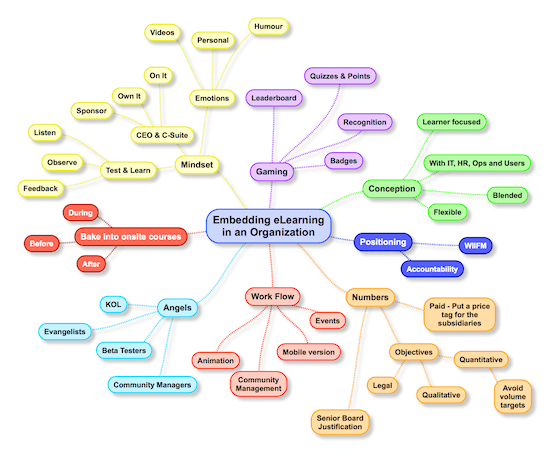I have heard many an HR executive fret about how to make the company’s eLearning platform more effective. One of the key issues is figuring out to embed the habit of learning online into the organization. There are a number of obstacles that keep coming up, such as:

- A legacy system that doesn’t offer enough functionality or flexibility
- An internal culture that is not adapted (no internal sharing, closed to social networks…)
- The organization is too decentralized
- The employees don’t feel they have enough time (overworked and stressed…)
- The online content is poor
- The user experience is sub-par
- …
Successful eLearning
Elearning in business is still very much in its embryonic stages. Corporate Learning for Development departments typically see the benefits and opportunities, but the delivery and uptake struggle to keep up with expectations. In order to make a successful eLearning deployment, here are the 8 different areas or levers that I believe need to come together.
- Positioning – The way that an eLearning platform is positioned can immediately set the right or wrong tone. If the platform is designed to “cut costs” and/or “tick boxes,” it’s a sure-fire way not to be successful.Success in embedding eLearning in your organization comes when the employees are held accountable for their own programs, which must be accessible and available on multiple devices and platforms.Is the What’s In It For Me? (WIIFM) emphatically clear for the learners? As Celia Richardson, Sr Manager at Deloitte Human Capital, says:
We really need to pay attention to making learning accessible and available and this means making in nimble and ‘chunked’ so it can easily be downloaded whether you are on an iphone, android, blackberry, ipad, tablet, etc.
- Conception – Online learning has been progressing at a much faster clip outside of schools and business via the informal learning that is available online through the likes of Khan Academy (free), Coursera, EdX, CodeAcademy… As a result, the expectations of staff (especially among the younger cadres) are much higher and the patience much lower for shoddy experiences. Online learning platforms must be developed with the right internal team, including HR (LFD), IT (systems), Operational Heads (pragmatism) and users (experience). Secondly, conception should be necessarily focused on the learners’ perspective (what we call “learned focused”). Thirdly, it should be flexible to allow for a varied and individualized path, with access via all types of devices, at all different times. The final point is that the online learning should be conceived from the get-go to be blended (i.e. that it can function well in onsite/in person sessions).

- Gaming. As basic as it sounds, learning should be fun. Thus, it is most relevant to introduce more or less subtle types of gaming. This can be in the form of quizzes, awarding badges, leaderboards and due recognition for different forms of contributions and activities. Another undervalued component of online learning is inciting “discovery.” By inserting surprises that stimulate curiosity, the learner’s instinct will be to explore.
- Mindset. Online learning is a major disruptive force in Education. And, to the extent most of today’s managers were not trained on it or have never properly delved into online instruction, it’s important that the decision-makers understand the disruptive elements of online learning. Unlike the formal, one-way instruction so many of us were accustomed to, in order to be effective and genuinely engaging, online learning must involve emotions Share on X. To find the right mix of content and the correct tone, it will require humility and a lot of testing and learning. Finally,
the fastest route to uptake is when the C-suite leads by example and personally follows and participates in the online programs Share on X - Bake Into Onsite (IRL) Courses. One of the most effective ways to make online learning part of the natural reflex of employees is to have certain parts of the in-person training incorporate online learning. This can include, for example, online reading ahead of the event, online games and quizzes during the training and further resources and networking in the period after the training.
- Angels. One of the keys to driving usage and engagement is to have some strong “Elearning Angels” who can help to test, evangelize and animate. These angels are ideally not part of the core team, but represent a strong group of power users who are recognized for their contributions.
- Work Flow. As we are all submerged by tasks and access to too much information, the need is to make the experience of going on to the online platform as efficient and seamless as possible. At a minimum, there should be a mobile version that is not held up by internal firewalls. Secondly, the online learning should be plugged into the internal social network as well as the greater resources of information. Celia Richardson writes, “as there is a convergence of online learning with knowledge management, we want to be able to ‘Google” within our own organization and either have immediate access to an answer to our question or have the option of some learning to help us go deeper into the subject.” Thirdly, one should consider having micro activities and events that help bring the online platform to life. This can be in the form of ad hoc cafés or plugged into meetings. As with any of the most effective and successful online learning initiatives, there is a community of learners that contribute to and learn from one another. As such, the organizing team should consider – at the outset, in any event – investing in active community management. Finally, as the system is being rolled out, a solid communication strategy is vital. Arguably, one might consider having an ongoing communication plan to accompany the developments (e.g. upgrades).
 Last and probably least important at the outset, except for getting approvals: Numbers. We’re all in business and senior management needs numbers by which to evaluate and approve the budget. However, setting objectives by which to be whipped, the platform may quickly be put in a difficult corner from which it is hard to get further funding and support. Setting the right and reasonable objectives for online learning must come in forms that are in line with the culture and the business objectives of the company. Objectives that are focused on the volume of users are to be avoided. For certain industries, the pedagogical objectives may be legally set, which one can consider a necessary evil. However, the money ball numbers will be in the form of qualitative experiences that help to move and motivate the learners. For example, a great indicator is how frequently the users return to the site.
Last and probably least important at the outset, except for getting approvals: Numbers. We’re all in business and senior management needs numbers by which to evaluate and approve the budget. However, setting objectives by which to be whipped, the platform may quickly be put in a difficult corner from which it is hard to get further funding and support. Setting the right and reasonable objectives for online learning must come in forms that are in line with the culture and the business objectives of the company. Objectives that are focused on the volume of users are to be avoided. For certain industries, the pedagogical objectives may be legally set, which one can consider a necessary evil. However, the money ball numbers will be in the form of qualitative experiences that help to move and motivate the learners. For example, a great indicator is how frequently the users return to the site.
If there is one key point in all this, it is that real learning can only happen when the individual is appropriately motivated and has responsibility for his/her own learning Share on X. It’s not because there is online learning that it should be considered a cost-reduced way to inform and teach. The best online learning programs will integrate informal learning, learning by doing, on the job training and a good deal of fun. The form of the material is every much as important as the content. Since the space is in constant evolution, the choice of partners (agency, platform & content creators) will be strategic.


 Last and probably least important at the outset, except for getting approvals: Numbers. We’re all in business and senior management needs numbers by which to evaluate and approve the budget. However, setting objectives by which to be whipped, the platform may quickly be put in a difficult corner from which it is hard to get further funding and support. Setting the right and reasonable objectives for online learning must come in forms that are in line with the culture and the business objectives of the company. Objectives that are focused on the volume of users are to be avoided. For certain industries, the pedagogical objectives may be legally set, which one can consider a necessary evil. However, the money ball numbers will be in the form of qualitative experiences that help to move and motivate the learners. For example, a great indicator is how frequently the users return to the site.
Last and probably least important at the outset, except for getting approvals: Numbers. We’re all in business and senior management needs numbers by which to evaluate and approve the budget. However, setting objectives by which to be whipped, the platform may quickly be put in a difficult corner from which it is hard to get further funding and support. Setting the right and reasonable objectives for online learning must come in forms that are in line with the culture and the business objectives of the company. Objectives that are focused on the volume of users are to be avoided. For certain industries, the pedagogical objectives may be legally set, which one can consider a necessary evil. However, the money ball numbers will be in the form of qualitative experiences that help to move and motivate the learners. For example, a great indicator is how frequently the users return to the site.









I’d add another point to take into account: connected tools that will become one of the bridges between organization and employees, bringing the dimension of RTW, measurement, videos, and unlimited connectivity to everything with the eLearning platforms and out of the organization itself.
By the way, many startups recently started to focus on the environment surrounding workers and the eLearning to bring light on improvements upon communication and empowerment.